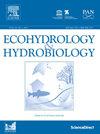The patchy distribution of groundwater copepods in the lowland river valley
IF 2.2
4区 环境科学与生态学
Q2 ECOLOGY
引用次数: 0
Abstract
Our research provides valuable insights into the uneven distribution of groundwater copepods in the lowland river valley ecosystem using an integrative taxonomy approach. The study was conducted in 101 wells in the Biebrza River Valley (northeastern Poland), which is one of the largest and best-preserved lowland rivers in Europe. It stands out for its exceptional biodiversity and pristine natural landscapes. Groundwater copepods were found in 49 of the 101 analyzed wells. We identified ten species of Copepoda and eight species of Cladocera. The most frequent copepods were Diacyclops bicuspidatus, Diacyclops crassicaudis, Canthocamptus staphylinus, Paracyclops cf. fimbriatus, Diacyclops bisetosus, and Eucyclops serrulatus. The aforementioned species were categorized as stygophiles, and no stygobionts were detected. Our findings suggest that the groundwater Copepoda community in this region is relatively stable and composed mostly of stygophiles along with stygoxenes. We did not find any significant impact of environmental parameters or different aquifers on the distribution of copepods, suggesting a patchy distribution of groundwater copepods in the lowland river valley. The relatively high presence of stygoxenes suggests that the exchange of organisms between surface water and groundwater plays a vital role in maintaining the diversity of microcrustaceans in lowland river valleys. Our study contributes to filling the knowledge gap regarding groundwater fauna in lowland Europe, particularly in areas affected by Pleistocene glaciations.
低地河谷地下水桡足类的斑块分布
我们的研究采用综合分类法,对低地河谷生态系统中地下水桡足类的不均匀分布提供了宝贵的见解。这项研究在比布扎河谷(波兰东北部)的 101 口水井中进行,比布扎河谷是欧洲最大、保存最完好的低地河流之一。该河谷以其特殊的生物多样性和原始自然景观而闻名于世。在 101 口分析井中的 49 口井中发现了地下水桡足类。我们发现了 10 种桡足类和 8 种栉足类。最常见的桡足类有 Diacyclops bicuspidatus、Diacyclops crassicaudis、Canthocamptus staphylinus、Paracyclops cf. fimbriatus、Diacyclops bisetosus 和 Eucyclops serrulatus。上述物种被归类为嗜风格生物,未检测到任何风格生物。我们的研究结果表明,该地区的地下水桡足类群落相对稳定,主要由风格嗜食者和风格嗜氧者组成。我们没有发现环境参数或不同含水层对桡足类的分布有明显影响,这表明低地河谷的地下水桡足类呈斑块状分布。相对较高的苯并庚烯含量表明,地表水和地下水之间的生物交换在维持低地河谷微型甲壳动物多样性方面发挥着重要作用。我们的研究有助于填补欧洲低地地下水动物群方面的知识空白,尤其是在受更新世冰川影响的地区。
本文章由计算机程序翻译,如有差异,请以英文原文为准。
求助全文
约1分钟内获得全文
求助全文
来源期刊

Ecohydrology & Hydrobiology
Agricultural and Biological Sciences-Aquatic Science
CiteScore
5.40
自引率
3.80%
发文量
51
期刊介绍:
Ecohydrology & Hydrobiology is an international journal that aims to advance ecohydrology as the study of the interplay between ecological and hydrological processes from molecular to river basin scales, and to promote its implementation as an integrative management tool to harmonize societal needs with biosphere potential.
 求助内容:
求助内容: 应助结果提醒方式:
应助结果提醒方式:


